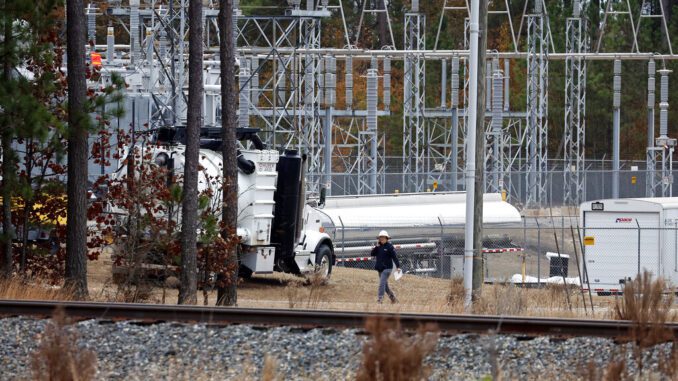
RALEIGH — The massive Dec. 3 criminal attack on the electric grid in Moore County isn’t the only recent act of vandalism resulting in a loss of power for thousands of customers.
On Friday, Nov. 11, a property owned by the Carteret-Craven Electric Cooperative (CCEC) in the Jones County town of Maysville was damaged. More than 12,000 CCEC customers were without power for approximately two hours, according to a statement from the cooperative.
“CCEC monitors its system constantly, and soon after the outage occurred, crews were dispatched to begin the restoration process and found that the Maysville substation had been vandalized. The Maysville substation remains off-line, but CCEC is fully able to serve all of its members through other substations,” a Nov. 11 statement reads.
The total cost of the damage was expected to exceed $500,000 and insurance investigators are still working to determine the extent of the damage. The cooperative said the vandals damaged transformers causing them to leak coolant oil.
Jake Joplin, CCEC CEO and general manager, stated that the cooperative “condemns this senseless act of vandalism.”
The Jones County Sheriff’s Department and State Bureau of Investigation were investigating the vandalism.
Much like the attack in Moore County, the attacks occurred close to military installations in the state. Maysville sits 33 miles from Camp Lejeune 41 miles from MCAS Cherry Point – two Marine Corps bases with nearly 50,000 active duty and reserve members enlisted.
Moore County sits just west of Fort Bragg, the largest military base in the United States. The substation attacks were first reported in Carthage, the Moore County seat which sits approximately 33 miles from the Army base.
In a press conference on Sunday, Dec. 4, Moore County Sheriff Ronnie Fields said the attack wasn’t random and the perpetrators “knew what they were doing.”
Law enforcement responded to the outages and found that two substations were damaged with multiple gunshots. A gate was rammed open at one of the properties to reach the intended target.
The attacks echo a similar coordinated attack on a substation in Metcalf, Calif. in 2013.
On April 16, 2013, a team of snipers shooting for 19 minutes knocked out 17 giant transformers that funnel power to Silicon Valley, the Wall Street Journal reported. Metcalf sits just outside of the city of San Jose.
The attack was “the most significant incident of domestic terrorism involving the grid that has ever occurred” in the U.S., said Jon Wellinghoff, who was chairman of the Federal Energy Regulatory Commission in 2013.
It took California utility workers 27 days to make repairs and bring the substation back to life. No one was arrested or charged in the attack.
Authorities ultimately came to believe the attack was committed by someone on the inside.
“While we have not yet identified the shooter, there’s some indication it was an insider,” said Caitlin Durkovich, assistant secretary for infrastructure protection at the Department of Homeland Security, at an energy industry conference, according to a CNN report.
Both Duke Energy and the Randolph Electric Membership Cooperative have said they expect to have power restored to Moore County residents by the end of the week.
“Equipment replacement is needed in some areas where damage is beyond repair. Technicians are working in 24-hour shifts to bring service back on as quickly as possible; however, due to the nature of the damage incurred, full restoration will take up until mid-day Thursday,” a Duke Energy statement reads.
The REMC says it has restored power to 1,276 total members at various times and for limited durations and anticipates the work may take until Wednesday to provide power at varying times to most of their impacted members.



